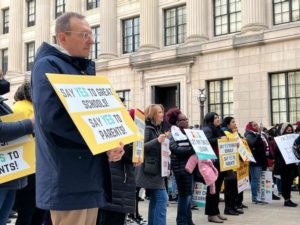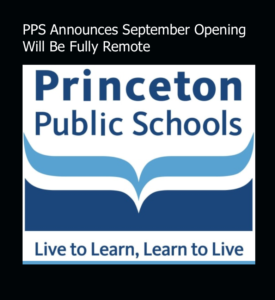Thank you, Professor Steve Danley, for generously continuing our conversation about Camden Public Schools. These exchanges are invaluable for dismantling some of the charter school vs. traditional school doggerel and I’m grateful for this opportunity to engage.
I’d like to focus on two points that Steve reiterates in his most recent response. First, he argues that renaissance schools — the innovative district/charter hybrids legislated through the Urban Hope Act passed by the N.J. State Legislature in 2012 — have an unfair marketing advantage in recruiting students because they have a “thumb on the scale.” Steve writes, “district leadership is not as protective of its schools as charter management is of theirs. And these schools then face dire consequences even though they are competing on an unequal playing field.” He writes, “district leadership, if you catch the right person on the right day, can be frank about realizing the challenges in making the new system equitable for district schools.”
Second, Steve says that I’m missing the larger context: parents in Camden are disenfranchised from “policy issues” and unrepresented in the “power dynamic,” including the original approvals of renaissance school proposals by the mayor-appointed school board.
Let’s start with what we agree on (besides that he’s a really nice guy and a hoot at cocktail parties!). We agree that many families in Camden are choosing to enroll their children in charter schools (that existed well before the approval of the Urban Hope Act) as well as relatively new renaissance schools. These choices pose fiscal and infrastructural problems for traditional schools, although these problems existed well before passage of the Urban Hope Act. (Current cost per pupil is $23,852 per year, some buildings are half-empty, etc..) And we agree that context, both in terms of public policy and educational reality, is really important.
Now let’s venture into a bit of our disagreements.
I, too, have had “frank moments” with district administrators and I’m convinced that the Rouhanifard Administration is fully committed to the continuity of traditional district schools. I guess we’re talking to different people. Camden administrators are actively marketing traditional choices through public meetings, open houses, and social media. I’m not sure what more they can do. Perhaps this is an opportunity to revisit the original mission of charters — “laboratories of innovation” — and incorporate some of their lessons about community outreach.
More importantly, Steve suggests that new renaissance schools were orchestrated in defiance of the desires of Camden residents. and passed against the will of the Camden School Board in expression of the “power dynamics.” He writes,” I’m arguing that truly engaging with parental perspectives can only happen when the policy context around them is understood.”
So let’s look at these contexts more closely so we can, as he says, “truly engage with parent perspectives.
The Urban Hope Act, which authorized new hybrid schools in Camden, Newark, and Trenton, was sponsored by Camden Democrats Senator Donald Norcross and Assemblyman Angel Fuentes. These are Camden’s duly-elected representatives, elected by voters in their districts.. The legislation passed overwhelmingly in the Statehouse, especially once NJEA voiced full-throated support in order to give “every child in New Jersey access to a great public school.”
(NJEA, post-passage, rescinded its support once it realized the popularity of renaissance schools.)
The Camden School Board did indeed initially vote down the first renaissance school proposal from KIPP Cooper Norcross Academy, which features extended school days, a vigorous college prep program, guaranteed enrollment for all children in the catchment area (including ELL and special ed), and partnerships with doctors and nurses from Cooper University Hospital and the Medical School of Rowan University Hospital.
But it’s not as cut and dried as Steve suggests. The vote was 4-4. Then, according to a Philadelphia Inquirer reporter, “the tipping ‘no’ vote came from city attorney Brian Turner, a rookie board member who often sits quiet at meetings. Turner arrived to the board just before the vote– almost six hours after the meeting had started — and voted down all proposals. As he walked out, I asked him why he voted the way he did but he declined to comment.” The Board passed KIPP’s proposal at a subsequent meeting.
The KIPP Academy opened in September with 700 students and, already, another 360 on the waiting list.
Let’s talk more about community engagement and parent preference.
Camden Public Schools is a district marked by decades of academic failure, the worst and most unsafe district in the state. Twelve years ago, Governor Jon Corzine’s Education Commissioner Lucille Davy declared, “I can’t get past [Camden’s] third- and fourth-grade reading and math scores, which are horrible.” The same year Executive Director David Sciarra of the Education Law Center, an adamant foe of the Urban Hope Act, said, “the woes in Camden point to a serious leadership problem. The state [Board of Education] has also lacked the capacity and will, until the last four to six months, to exercise its responsibility to step in and take control.”
In 2010 80.7% of Camden High’s juniors and seniors failed the state assessment in language arts (an 8th grade level test). So many of them failed the math portion that the NJ DOE data field has an asterisk for all levels in order to protect confidentiality. Average SAT scores were 330 in math and 340 in verbal. No Advanced Placements courses were offered. The graduation rate was 42.1%.
In 2013 Woodrow Wilson High School met 0% of its performance targets in the area of Graduation and Post-Secondary. No student got a 1550 or higher on the SAT (a measure of college-career readiness), no student took at A.P. test, and 72% failed the state’s basic skills test in math.
The first good news for Camden was the 2013 appointment of Superintendent Paymon Rouhanifard, an ardent advocate for public education.
I don’t think parents are choosing renaissance and charter schools because the “power dynamics” have been subverted. I don’t think they’re choosing public alternative schools because there’s a “thumb on the scale” or we’re missing out on policy contexts or Camden traditional districts have inadequate marketing. I don’t think parents are choosing renaissance schools because, as your ally Julia Sass Rubin claimed, “people in abject poverty don’t have the bandwidth to even evaluate charter schools.” I think parents are exercising their right to school choice because they don’t want their kids to go to Camden High or Woodrow Wilson.
Would you?
By the way, Steve, I’d love to take you up on that invitation to a drink or dinner. And let’s continue this conversation.




